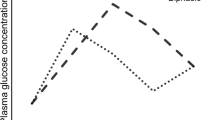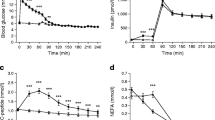Abstract
The aim of the study was to investigate the dynamics of venous blood glucose, insulin, and C-peptide in response to an intake of a mixed meal normalized to body mass in obese patients without and with type 2 diabetes mellitus. Venous blood samples were taken from seven healthy subjects, nine obese patients, and ten obese patients with type 2 diabetes mellitus (mean duration of diabetes 7 years) before and 30, 60, 90, 120, and 180 min after a mixed meal (6 kcal/kg of body mass); additionally, nine patients with obesity and type 2 diabetes mellitus and three healthy volunteers completed the hyperinsulinemic-euglycemic clamp test. In patient groups the energy content of food did not differ but was 1.8 times higher than in the control. An increase in glucose level 1 h after a meal was maximal in patients with type 2 diabetes, and an increase in insulin and C-peptide was higher in obese patients, which is related to impairment of insulin-dependent glucose uptake by tissues and of the rate of insulin secretion (dysfunction of beta-cells) in patients. At the same time, an increase in the total area under the curve “C-peptide–time” demonstrates that the maximal secretory response of beta-cells is comparable in obese patients without and with type 2 diabetes mellitus. The absolute blood glucose level 90 min after a meal closely correlated with the M-index—the marker of systemic sensitivity to insulin (rs = –0.82, p = 0.002). Our results characterize the features in the regulation of carbohydrate metabolism after intake of a mixed meal, normalized to body mass, in people with varying severity of metabolic disorders, and open up prospects for a wider application of this test in practice.



Similar content being viewed by others
REFERENCES
Dedov, I.I., Shestakova, M.V., Vikulova, O.K., et al., Epidemiological characteristics of diabetes mellitus in the Russian Federation: clinical and statistical analysis according to the Federal Diabetes Register data as of January 01, 2021, Sakh. Diabet, 2021, vol. 24, no. 3, p. 204.
Wang, Q., Jokelainen, J., Auvinen, J., et al., Insulin resistance and systemic metabolic changes in oral glucose tolerance test in 5340 individuals: an interventional study 2, BMC Med., 2019, vol. 17, no. 1, p. 217.
Shankar, S.S., Vella, A., Raymond, R.H., et al., Standardized mixed-meal tolerance and arginine stimulation tests provide reproducible and complementary measures of beta-cell function: results from the Foundation for the National Institutes of Health Biomarkers Consortium Investigative Series, Diabetes Care, 2016, vol. 39, no. 9, p. 1602.
Tura, A., Morbiducci, U., Sbrignadello, S., et al., Shape of glucose, insulin, C-peptide curves during a 3‑h oral glucose tolerance test: any relationship with the degree of glucose tolerance? Am. J. Physiol.: Regul. In-tegr. Comp. Physiol., 2011, vol. 300, no. 4, p. R941.
Draznin, B., Aroda, V.R., Bakris, G., et al., 2. Classification and Diagnosis of Diabetes: Standards of Medical Care in Diabetes-2022, Diabetes Care, 2022, vol. 45, no. 1, p. S17.
Rijkelijkhuizen, J.M., Girman, C.J., Mari, A., et al., Classical and model-based estimates of beta-cell function during a mixed meal vs. an OGTT in a population-based cohort, Diabetes Res., Clin. Pract., 2009, vol. 83, no. 2, p. 280.
van Bussel, I.P.G., Fazelzadeh, P., Frost, G.S., et al., Measuring phenotypic flexibility by transcriptome time-course analyses during challenge tests before and after energy restriction, FASEB J., 2019, vol. 33, no. 9, p. 10280.
Vorotnikov, A.V., Popov, D.V., and Makhnovskii, P.A., Signaling and gene expression in skeletal muscles in type 2 diabetes: current results and OMICS perspectives, Biochemistry (Moscow). 2022, vol. 87, no. 9, p. 1021. https://doi.org/10.1134/S0006297922090139
McQuaid, S.E., Hodson, L., Neville, M.J., et al., Downregulation of adipose tissue fatty acid trafficking in obesity: a driver for ectopic fat deposition? Diabetes, 2011, vol. 60, no. 1, p. 47.
Bastarrachea, R.A., Laviada-Molina, H.A., Nava-Gonzalez, E.J., et al., Deep multi-OMICs and multi-tissue characterization in a pre- and postprandial state in human volunteers: the GEMM family study research design, Genes (Basel), 2018, vol. 9, no. 11, p. 532.
Small, L., Brandon, A. E., Parker, B. L., Desh-pande, V., Samsudeen, A. F., et al., Reduced insulin action in muscle of high fat diet rats over the diurnal cycle is not associated with defective insulin signaling, Mol. Metab., 2019, vol. 25, p. 107. https://doi.org/10.1016/j.molmet.2019.04.006
Ware, J., Jr., Kosinski, M., and Keller, S.D., A 12-Item Short-Form Health Survey: construction of scales and preliminary tests of reliability and validity, Med. Care, 1996, vol. 34, no. 3, p. 220.
DeFronzo, R.A., Tobin, J.D., and Andres, R., Glucose clamp technique: a method for quantifying insulin secretion and resistance, Am. J. Physiol., 1979, vol. 237, no. 3, p. E214.
Cerf, M.E., Beta cell dysfunction and insulin resistance, Front. Endocrinol. (Lausanne), 2013, vol. 4, p. 37.
Kossler, T., Bobrov, P., Strassburger, K., et al., Impact of mixed meal tolerance test composition on measures of beta-cell function in type 2 diabetes, Nutr. Metab. (London), 2021, vol. 18, no. 1, p. 47.
Paglialunga, S., Guerrero, A., Roessig, J.M., et al., Adding to the spectrum of insulin sensitive populations for mixed meal tolerance test glucose reliability assessment, J. Diabetes Metab. Disord., 2016, vol. 15, p. 57.
ACKNOWLEDGMENTS
The authors are grateful to Ph.D. I.A. Sklyanik (Institute of Diabetes, State Scientific Center of the Russian Federation, Federal State Budgetary Institution “NMITs of Endocrinology,” Ministry of Health of Russia, Moscow) for his help in working with patients.
Funding
The study was supported by the Russian Science Foundation (grant no. 21-75-10 146).
Author information
Authors and Affiliations
Corresponding author
Ethics declarations
All studies were conducted in accordance with the principles of biomedical ethics as formulated in the 1964 Declaration of Helsinki and its subsequent updates and approved by the Biomedical Ethics Committee of the Institute of Biomedical Problems of the Russian Academy of Sciences (Moscow), No. 613 of March 29, 2022 and the Local Ethics Committee of the National Medical Research Center for Endocrinology (Moscow), No. 4 of February 14, 2022.
Each participant in the study provided a voluntary written informed consent signed by him after explaining to him the potential risks and benefits, as well as the nature of the upcoming study.
CONFLICT OF INTEREST
The authors of this work declare that they have no conflicts of interest.
Additional information
Publisher’s Note.
Pleiades Publishing remains neutral with regard to jurisdictional claims in published maps and institutional affiliations.
Rights and permissions
About this article
Cite this article
Lednev, E.M., Gavrilova, A.O., Vepkhvadze, T.F. et al. Disturbances in Dynamics of Glucose, Insulin, and C-Peptide in Blood after a Normalized Intake of a Mixed Meal in Obesity and Type 2 Diabetes Mellitus. Hum Physiol 49, 668–674 (2023). https://doi.org/10.1134/S0362119723600297
Received:
Revised:
Accepted:
Published:
Issue Date:
DOI: https://doi.org/10.1134/S0362119723600297




